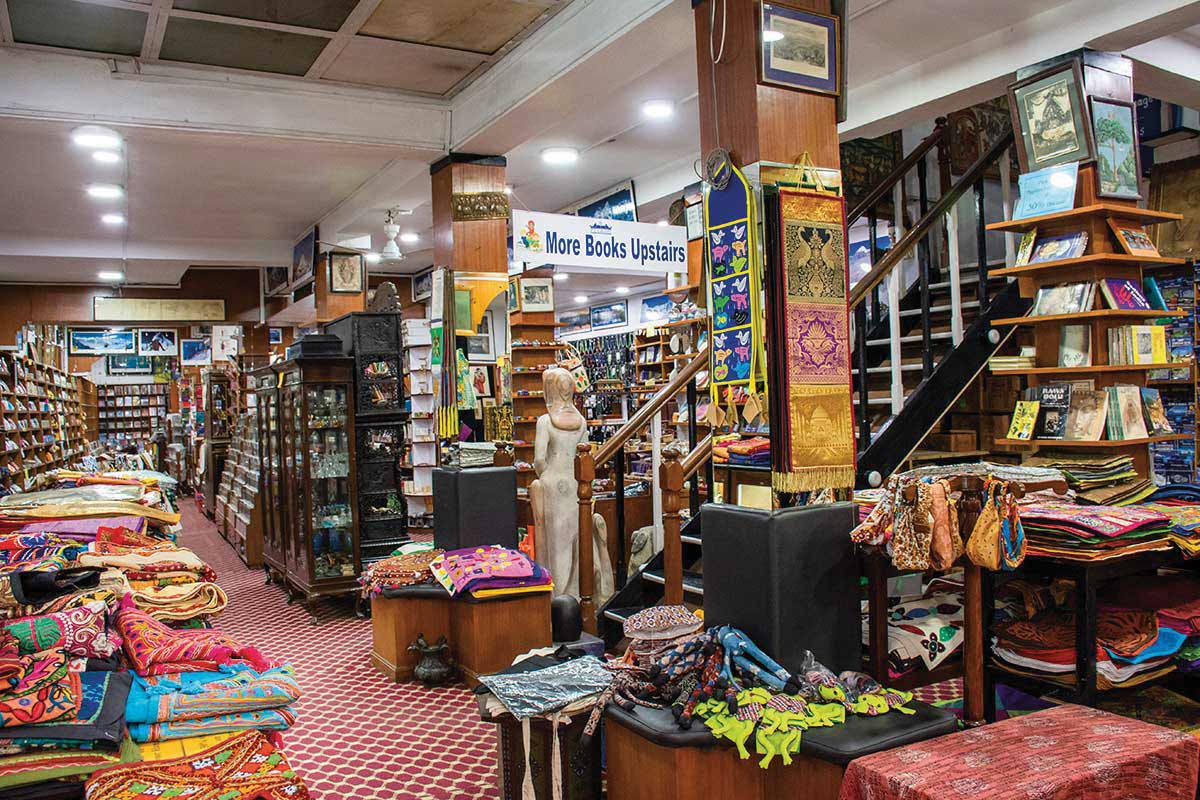With a history as grand as the building itself, Nineteen O Five has lived many lives and in many different times.
Some buildings possess a charm that derives from the ambience around them, a history written into the walls that breathes into the living present. Nineteen O Five in Kathmandu is such a relic from a hundred years ago which needs to be preserved. I see her as an old fashioned lady of grace, a little eccentric in her ways perhaps, but worth listening to with her remarkable stories…
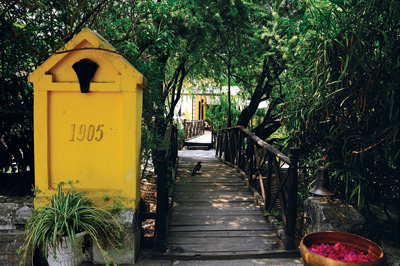 On the pediment on front is inscribed the date of 1905, telling you her age. Surrounded by tall trees that are at least eighty to a hundred years old, you can see blue pine and purple jacaranda and oak rising tall behind the building. The place resonates with the orchestra of birds before sunset, with cackling geese on lazy afternoons when sunshine filters through creepers on to the verandah. Stories percolate of those who lived here such as the French writer Michel Peissel and the German architect Robert Weise with his family, of books that were written here like Tiger for Breakfast and others where it finds mention.
On the pediment on front is inscribed the date of 1905, telling you her age. Surrounded by tall trees that are at least eighty to a hundred years old, you can see blue pine and purple jacaranda and oak rising tall behind the building. The place resonates with the orchestra of birds before sunset, with cackling geese on lazy afternoons when sunshine filters through creepers on to the verandah. Stories percolate of those who lived here such as the French writer Michel Peissel and the German architect Robert Weise with his family, of books that were written here like Tiger for Breakfast and others where it finds mention.
Nineteen O Five is built in the neo-classic style found in Rana palaces of the early twentieth century in Nepal. This hybrid style was described by Boris and others as ‘Kathmandu Baroque’ – which made it a distinct improvement over ‘Punjabi Baroque’ in India that muddles together Greek columns with French windows and Moorish arches. But Nineteen O Five is different from Rana palaces! There are no imposing facades with towering pillars and pediments, no glittering durbar halls with stucco decoration, and no inner courtyard so indispensable to Nepali and Newari houses. The building is smaller than Rana mansions with its intimate rooms, and a wide wooden verandah running the length of the front, graced with slender fluted pillars and wrought iron railings.
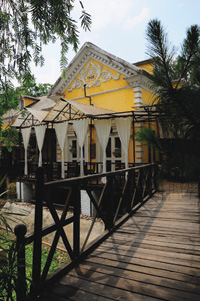 Unique in planning and layout, lightness and informality distinguish the place. For whom was it built by Rudra Shamsher Rana before it was given over to European writers and architects? Why it was built in this unique manner adds to its mystery. The spacious verandah is as important as the interior rooms, so that the resident or visitor spends time taking in the environment of water and verdant landscape.
Unique in planning and layout, lightness and informality distinguish the place. For whom was it built by Rudra Shamsher Rana before it was given over to European writers and architects? Why it was built in this unique manner adds to its mystery. The spacious verandah is as important as the interior rooms, so that the resident or visitor spends time taking in the environment of water and verdant landscape.
The building rises above water, with the approach across a wooden bridge – a romantic setting like the arched bridges found in Japanese woodcuts. And as in these woodcuts, an old bottlebrush like an ancient willow tree bends its branches gracefully into the water. White geese strut around as thought they own the place and wade into the water now covered with water hyacinths. By strange coincidence these geese find mention in Peissel’s book as inhabiting the place fifty years ago! For some time though, they were replaced by forty-three Yorkshire pigs, squealing and snorting, when Boris decided to import them from his good friend the Maharajah of Cooch Behar in eastern India, to set up Nepal’s first piggery.
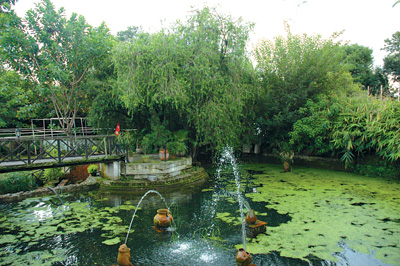 Those were the grand times of the legendary Boris Lissanevitch who came originally from Russia, via his adventures with Ballet Russe in Paris and Monte Carlo in the gay 1920s. Boris was placed in charge of the coronation of King Mahendra in the mid fifties and later the visit of Queen Elizabeth to Nepal, when he arranged the best amenities for ambassadors, visitors and press arriving from all over the world to what was then a medieval kingdom. The Royal Hotel became the venue for banquets for visits of Prime Minister Nehru from India. At that time the hotel grounds extended into Nineteen O Five, used by Boris for his own guests. Originally water enclosed the entire building extending around the front and sides. This gives a clue to its purpose – two rusted iron rings remain as evidence on the landing near the bridge. So the building was built as a place of retreat and relaxation, a ‘Summer House’ in the style of the British whom the Ranas liked to emulate.
Those were the grand times of the legendary Boris Lissanevitch who came originally from Russia, via his adventures with Ballet Russe in Paris and Monte Carlo in the gay 1920s. Boris was placed in charge of the coronation of King Mahendra in the mid fifties and later the visit of Queen Elizabeth to Nepal, when he arranged the best amenities for ambassadors, visitors and press arriving from all over the world to what was then a medieval kingdom. The Royal Hotel became the venue for banquets for visits of Prime Minister Nehru from India. At that time the hotel grounds extended into Nineteen O Five, used by Boris for his own guests. Originally water enclosed the entire building extending around the front and sides. This gives a clue to its purpose – two rusted iron rings remain as evidence on the landing near the bridge. So the building was built as a place of retreat and relaxation, a ‘Summer House’ in the style of the British whom the Ranas liked to emulate.
Now that the Royal Hotel no longer exists, it has been rebuilt as the Election Commission Building and its premises sealed off with high walls and guards. For awhile 1905 became the site for a Japanese restaurant, so appropriate with its water and bridges – after which it fell into disuse for years. But the demise of the old lady was averted once again. In 2004, Nineteen O Five was rented in 2004 by Shobha Rayamajhi who put all her energies into restoring the building to regain character and purpose. Renting the building transformed her life when she changed her career from being a consultant on Mac computers to becoming proprietor of a cherished restaurant. She furnished it with elegance in the interiors and a rustic feel to tables on the wooden verandah.
Shobha removed the water skirting the sides of the building, which she replaced with a garden with trees and giant plants - where dinner parties and evening concerts are held. The Farmer’s Market on Saturdays, a remarkable enterprise begun in May 2009 and now replicated elsewhere in the city, is a great meeting point. It is a festive weekly event where stalls sell everything from organic vegetables, avocados and strawberries to jams, Himalayan honey and juice and herbal teas to fresh breads and cookies. Francoise from France brings his farm produce of sausages and smoked ham while next to him the Italian sells parmesan cheese, and further along is Eva from Poland roasting delicious fresh chicken. The Yoga Ashram offers fresh yoghurt, milk, ghee, brown rice, and the French monk sells pasta, potted herbs et al to keep his orphanage running.
Some activities of the legendary Royal Hotel have spilled into Nineteen O Five – today it has become a regular haunt for expatriates and Nepalis who find the verandah and the bar the ideal place to relax. Not an elite club or a night club, it possesses the quality of both. For some who gather there is a sense of belonging to a fraternity that extends beyond cultural divides. Yoga classes are held in the evenings; Tai Chih exercises, and now the meditation classes are about to begin.
Every enterprising adventure has a life span. The dream that was the Royal Hotel closed in its time. Nineteen O Five is threatened by being bought over by a bank, to be rebuilt as another building in glass and concrete. Will the grand old lady now over a hundred years old, with her charms and popularity, await the day when she will be demolished? Or can something be done to avert this? ■
How I started 1905
Proprietor Shobha Rayamajhi of the 1905 building and restaurant reminisces about the early days of this amazing oasis in Kathmandu
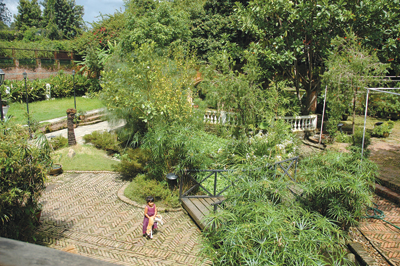 Ten years ago there were not very many restaurants. Not in my wildest dreams had I thought that I would run a business, let alone a restaurant! When I discovered the 1905 property though, it felt like a jigsaw puzzle; I discovered the entrepreneurial side to me along with my passion for old buildings and an enthusiasm to work independently. Right away I was interested in setting up a business on this then-neglected piece of amazing property. The results of that labor of love, stands today for all to see. Even though my skills in running a restaurant were very minimal at the time, with my entrepreneurial streak, I took this opportunity very seriously and learnt a lot from trials and errors. Being an IT graduate, I went ahead and learnt the trick of the trade in business as well as structured my business from the bottom up; I couldn’t have learned the lessons I did here at any academic institution anywhere in the world.
Ten years ago there were not very many restaurants. Not in my wildest dreams had I thought that I would run a business, let alone a restaurant! When I discovered the 1905 property though, it felt like a jigsaw puzzle; I discovered the entrepreneurial side to me along with my passion for old buildings and an enthusiasm to work independently. Right away I was interested in setting up a business on this then-neglected piece of amazing property. The results of that labor of love, stands today for all to see. Even though my skills in running a restaurant were very minimal at the time, with my entrepreneurial streak, I took this opportunity very seriously and learnt a lot from trials and errors. Being an IT graduate, I went ahead and learnt the trick of the trade in business as well as structured my business from the bottom up; I couldn’t have learned the lessons I did here at any academic institution anywhere in the world.
I slowly brought back life to the musty and stuffy, dilapidated property. The stale and smelly water was drained out and trucks of trash and debris were removed from the man-dug pond, which was once a swimming pool for many expats. The natural landscape concept helped inhabit aquatic plants and animals around the property.
The inscription 1905 (the year the building was built) was found in the old building, thus giving the name to 1905 Restaurant in Kantipath. The premises are also known as Bahadhur Bhawan.The palace itself was called Char bhuje with four corners on the roof. The 1905 building was made for the Rana family as a summer house .and the building is just a small part of the huge Rana family palace. In the beginning I was bit apprehensive, since it was not the best time for many businesses. But later everything became interesting and challenging especially when I met and shared many happy stories of this property with Mr. Michelle Pyssel, the author of Tiger for breakfast, who had visited Nepal after decades.
The 1905 restaurant now serves many locals, expats and tourists. Our breakfast and lunch menus cater to healthy eaters who need to go back to work quickly, along with appropriately selected meat and fresh, hand-made pasta dinners. The restaurant’s serene premises also host Pranamaya Yoga and Tai Chi classes.
To promote local farmers, we started the unique, weekly Farmers market (Every Saturday:9 am till noon) which we started three years ago. It has become one of the best places to get fresh, organic produce such as hand-made cheese (chèvre, mozzarella, feta, French), baked goodies, jams, honey, fresh milk and much more. ■


